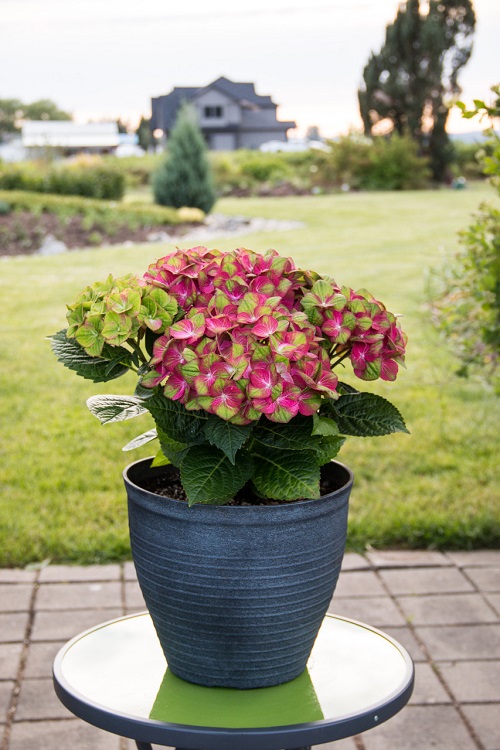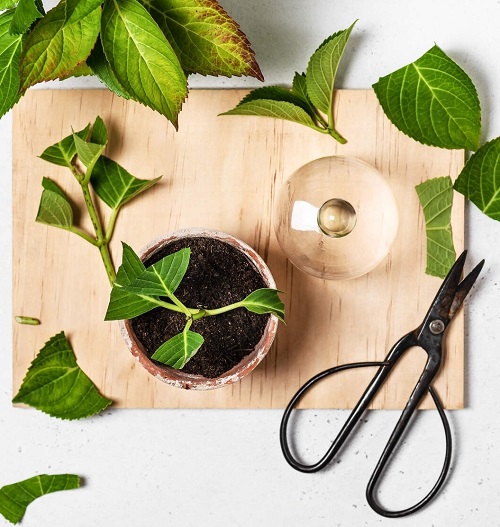Pistachio Hydrangea showcases a lively combination of colors, which makes it stand out from the other varieties like a champ!
Meet Pistachio Hydrangea, a vibrant showstopper that transforms any garden into surreal colors. Its flowers carry a beautiful combination of colors, creating a spectacle from late spring to early fall.
Check out Master Gardener’s Tricks to Grow Successful Hydrangeas here
Pistachio Hydrangea Information
Origin
- Breeding: This cultivar is the result of specialized breeding programs aimed at creating unique and visually stunning plants.
- Native Regions: While the Pistachio Hydrangea is a cultivar, Hydrangea macrophylla is native to Japan and China.
The Unique Name
The flowers typically exhibit a mix of vibrant hues such as pink, green, and sometimes a touch of blue, closely resembling the color of pistachio nuts. This coloration sets it apart from the more traditional pink, blue, or white hydrangeas and lends it its catchy, descriptive name.
Appearance
- Size: Typically grows to a height and width of 3-5 feet, making it suitable for small to medium-sized gardens.
- Leaves: The leaves are broad and dark green, providing a lush backdrop for the vibrant blooms.
Colors of Flowers
- Multi-Colored: What sets the Pistachio Hydrangea apart is its multi-colored blooms. They start as a deep green, transitioning into a blend of red, pink, and purple.
- Vivid Hues: The colors are incredibly vivid, especially when exposed to morning sunlight and when planted in slightly acidic soil.
Learn How to Make Your Hydrangea Purple here
Propagating Pistachio Hydrangea
Methods to Propagate Pistachio Hydrangea:
- Softwood Cuttings
- Hardwood Cuttings
- Division
The easiest method to propagate Pistachio Hydrangea is through softwood cuttings. Here’s a detailed explanation of this method:
- Softwood cuttings are best taken in late spring to early summer when the plant is actively growing. Choose a healthy branch with no signs of disease or stress.
- Using clean pruning shears or a sharp knife cut a 4 to 6-inch (10 to 15 cm) section of a young, green stem just below a leaf node (where leaves are attached). Remove any leaves from the lower half of the cutting, leaving a few at the top.
- Apply Rooting Hormone: To increase the chances of successful rooting, you can dip the cut end of the stem in rooting hormone powder. This step is optional but can expedite the process.
- Fill a small pot or container with a well-draining potting mix. Insert the cut end of the stem about 1 to 2 inches (2.5 to 5 cm) deep into the soil. Firmly press the soil around the cutting to ensure good contact.
- To maintain high humidity, cover the potted cutting with a plastic bag or plastic wrap. This will create a mini greenhouse effect, promoting root development.
- Place the pot in a location with bright, indirect light. Avoid direct sunlight, as it can overheat the cutting.
- Keep the potting mix consistently moist but not waterlogged. Check regularly to ensure the soil doesn’t dry out.
- After several weeks, gently tug on the cutting. If you feel resistance, it’s an indication that the roots have formed.
Best Pot Size for Growing Pistachio Hydrangea
You can start the plant in a 12-14 inch pot, which will be good for a few years to come. Based on its spread, re-pot into a one size bigger pot than the old one when the need arises.
Check the Best Types of Purple Hydrangea Varieties here
Requirements for Growing Pistachio Hydrangea

Light
Aim to give your Pistachio Hydrangea at least 4-6 hours of sunlight each day. This is generally sufficient for optimal bloom color and density.
The ideal situation is bright morning sun, which provides the intensity required for vibrant blooms without the harshness that could cause leaf scorch.
If you live in a hotter climate, consider placing the plant in a location where it can receive partial afternoon shade to protect it from extreme temperatures.
Soil
Pistachio Hydrangea thrives in well-draining, slightly acidic to neutral soil with a pH range of 6.0 to 7.0. The best potting mix to use is:
- Organic Matter: 40-50% – Peat Moss or Coco Coir: 20-25% and Compost: 20-25%.
- Drainage Materials: 30-40% – Perlite or Sand: 20-25% and Pine Bark: 10-15%
- Soil Base: 10-20% – Garden Soil: 10-20%
Water
Water deeply at the base of the plant – this encourages the roots to grow deeper, making the plant more drought-resistant. Also, avoiding wetting the leaves to prevent fungal issues.
Saturating the growing medium 2-3 times a week is usually sufficient, or whenever the topsoil feels a little dry to the touch.
Pro Tip: Early morning is the best time to water your Pistachio Hydrangea. Watering in the late afternoon or evening can lead to diseases due to overnight moisture on the leaves.
Temperature
Highest Temperature
Up to 90°F (32°C)
In temperatures higher than this, the plant may experience stress, affecting its overall health and bloom quality.
Lowest Temperature
Down to 30°F (-1°C)
While Pistachio Hydrangeas can tolerate short periods of frost, sustained temperatures below freezing can cause significant damage.
Read Tips and Tricks on Pruning Oakleaf Hydrangea here
Pistachio Hydrangea Care

Fertilizer
- Opt for a liquid fertilizer with a balanced N-P-K ratio, such as a 10-10-10 or 14-14-14.
- If you’re primarily interested in flower production, consider a liquid fertilizer high in phosphorus, such as a 10-30-20 ratio.
- During the growing season (spring and summer), you can apply liquid fertilizer every 4-6 weeks. Follow the manufacturer’s instructions for proper dilution and application rates.
Pruning
Pistachio Hydrangeas should be pruned in late winter or early spring before new growth begins. Remove dead or weak branches and any spent flower heads to encourage new blooms.
Use sharp, clean pruning shears, and make cuts just above a healthy bud or branch junction. Avoid heavy pruning to preserve the plant’s shape and size.
Pests and Diseases
1. Aphids: These small, soft-bodied insects can cluster on the leaves, causing damage by sucking sap from the plant. You can control them with insecticidal soap or a strong stream of water.
2. Spider Mites: These tiny pests can create fine webbing on the leaves and cause stippling or discoloration. Regularly misting the plant and using insecticidal soap can help manage them.
3. Powdery Mildew: This fungal disease appears as a white, powdery substance on the leaves. Ensure good air circulation around the plant and avoid overhead watering to prevent powdery mildew. Fungicidal sprays can be used if the problem persists.
4. Leaf Spot: Leaf spot diseases can cause dark, irregular spots on the leaves. Remove and destroy affected leaves, and ensure the plant has good air circulation and proper spacing.
5. Chlorosis: If the soil pH is too high, the leaves may develop yellowing, a condition known as chlorosis. Adjusting the soil pH to the appropriate range (6.0 to 7.0) can help resolve this issue.
6. Root Rot: Overwatering or poorly drained soil can lead to root rot. Ensure the soil is well-draining and allow it to dry slightly between waterings to prevent this fungal disease.
Find What Side of the House Do You Plant Hydrangeas here
Pistachio Hydrangea – FAQs
1. Can Pistachio Hydrangeas Be Grown Indoors?
Yes, they can be grown indoors but require ample space and proper air circulation to thrive. You’ll also need to pay attention to indoor pests like spider mites and aphids.
2. How Big Do Pistachio Hydrangeas Get?
Typically, Pistachio Hydrangeas grow to a height and width of 3-5 feet. This makes them suitable for both container gardening and planting in small to medium-sized gardens.
3. Are Pistachio Hydrangeas Deer-Resistant?
No, hydrangeas, in general, are not considered deer-resistant. If deer are a concern in your area, you may need to take additional protective measures like fencing or repellents.
4. How Long Do the Blooms Last?
One of the standout features of Pistachio Hydrangeas is their long blooming season. You can expect vibrant blooms from late spring until early fall.
5. Are Pistachio Hydrangeas Pet-Friendly?
No, hydrangeas contain compounds that can be toxic to dogs and cats if ingested. Keep pets away from the plant to avoid any potential health issues.
6. Do Pistachio Hydrangeas Change Color?
The flower color of Pistachio Hydrangeas is generally stable due to its genetic makeup and not highly susceptible to changes in soil pH.
7. What are Good Companion Plants for Pistachio Hydrangea?
Plants that enjoy similar growing conditions like hostas, ferns, and astilbes make good companions for Pistachio Hydrangeas.



